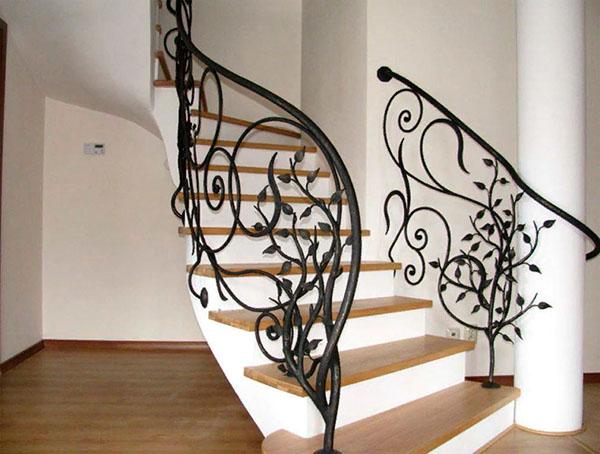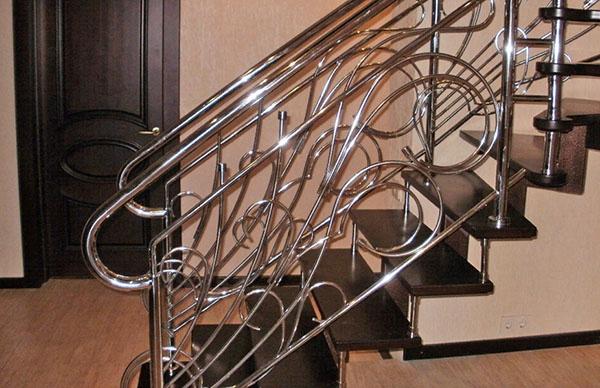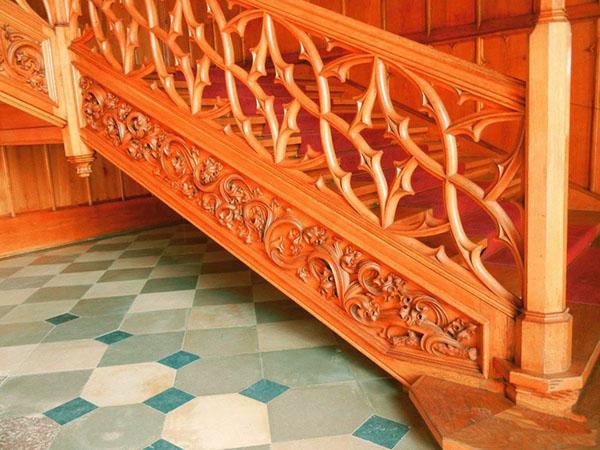What are the railing for stairs and how to choose the right one

Fencing is one of the important components of any staircase. A properly installed stair railing protects against falls, and its outer the appearance has a noticeable effect on the interior of the room. All this should be considered when choosing the material of the fence, the type and method of design of the railings designs. While the dimensions and other features of the fence are chosen in accordance with safety requirements.
Railing requirements

The main task of such fences is considered to ensure comfortable and safe movement up the stairs and prevent a person from falling from a height. To increase safety when designing handrails, certain requirements for their dimensions, materials and placement are required.
The basic rules that are worth knowing about both the owners of the buildings where the stairs are installed, and the designers and installers, are as follows:
- the height of the railings on the stairs in a private house, apartment and any other room should be within 90-100 cm;
- the distance between the posts is about 60 cm;
- filling is required between the supports;
- when installing the handrail against the wall, the distance to it should be at least 7 cm;
- cross-sectional area of the handrail - not less than 50 sq. mm;
- the ends of the railing should be rounded and protrude 30 cm beyond the line of the last steps.
For a wooden fence in the absence of filling, the distance between the balusters is recommended to be reduced to 10-15 cm. This requirement ensures the safety of children using the ladder.
For wide aisles, stair railings should be on both sides. For narrow stairs, one-sided placement of the fence is allowed. The surface of the handrails should be smooth to avoid scratches and splinters, but not slippery. At the beginning and at the end of the staircase, stronger and more powerful supports are installed. They provide fastening of metal railings and serve as an additional decorative element for a wooden staircase.
Structural elements

Structurally, a handrail for a staircase can consist of the following parts:
- Balusters. Racks to secure the railing. Depending on the appearance, they can also perform a decorative function.
- Handrails. The top of the stair rail to hold onto when moving. Can be attached to balusters or walls.
- Baluster bar. Railing element for stairs, installed on the bowstring and designed to secure the bottom of the balusters.
- Additional filling posts, including intermediate and angled ones.
For attaching balusters to steps pins, screws and dowels are used. Racks can be connected to each other with using special strips. When installing the handrail on the wall, use brackets.
Installation method

According to the mounting method, you can highlight three options for handrails for stairs in the house. The most popular type is classic fencing, installed using posts and balusters. The design may include horizontal framing and filling between the supports. The material of such railings can be almost anything - from wood to concrete.
A less popular type of railings are handrails. They are mounted on the walls, leaving an appropriate distance for the hands. The construction includes a straight metal tube or profile, and fasteners.
In public buildings, prefabricated railings are often installed on stairs. They are a set of individual elements, assembled in accordance with the configuration of the march, and are usually made of metal and glass.
Construction materials
Choosing the right types of railings for stairs, you should choose the right one material. The most popular options are fences made from wood and metal. Less commonly used options are made of plastic, concrete or brick. IN modern interior looks good combined designs, in the composition which may include glass elements. The choice of material is influenced by the style premises, requirements for the strength and price of the staircase.
Metal railing for stairs

Metal is considered the second most common fencing material in private homes and apartments and the first when we consider offices, shopping centers and industrial premises.
Basically, metal railings for stairs are made from the following materials:
- aluminum;
- stainless steel;
- cast iron;
- wrought iron.
The advantages of aluminum fencing is corrosion resistant and easy to install. However, due to low strength, such railings are installed mainly in rooms with gentle operating conditions. Aluminum is often used in the composition combined fences.
There are no disadvantages to aluminum construction with stainless steel. With its help, you can make the design of the stair railings, which will be combined with any interior style. The steel is suitable for indoor and outdoor mounting. And glass is often used to fill the space between the steel posts.
"Stainless steel" is the best option for a spiral staircase. It provides sufficient strength and allows you to get any form of fencing easier than wood.
Wrought iron is often chosen as the material for decorative railings. With high aesthetic characteristics, it will provide an exclusive view to any room. The only serious drawback of forged structures is high price.
Wooden railing

The tree continues to remain the most common material for stairs and railings. The advantages of wood are aesthetic appearance, environmental friendliness and lightness. Also, wooden railings for stairs more pleasant to the touch and warmer.
Among the disadvantages of wood are low strength and instability to high humidity. Wood does not differ in durability, therefore, railings made from it often require repair and restoration in comparison with other materials.
If wooden fences are properly treated with antiseptics and paints and varnishes, they will last at least 15-20 years.
Other options

For the manufacture of street railings from wood, concrete is often used. They also use it for decoration indoor stairs - first of all, in large buildings with wide flights of stairs. The advantages of concrete structures are reliability and durability, the disadvantages are significant weight and complex manufacturing.

The infrequently used plastic stair railings are simple assembly, durability, moisture and insect resistance. Products made of plastic can be used to simulate other materials - for example, wood. The disadvantages of the plastic construction include low strength and the possibility of cracks appearing under strong mechanical stress. Such the material is suitable for the railing of a low staircase.

One of the best in aesthetic plan options - glass railings for stairs, photo which show how attractive a flight of stairs will look. Glass gives the structure lightness and looks great in the office, apartment, retail center or club.However, the fragility of the material makes it not very popular. for use in private homes, although it is often used for filling between metal racks.

Combined type combines elements from different materials. It can be glass and metal wood and wrought iron railings, castings and plastic. The advantage of combined stair railing is exclusive design. Among the disadvantages are complex installation and high cost.
Features of location and design

To increase safety and improve the appearance between the main posts and balusters, an infill is installed:
- classic, which is additional racks installed vertically or at an angle;
- solid - in the form of panels and sheets of metal, wood or glass;
- artistic - such a design of the stair railings when the space between the supports is filled with curly elements;
- crossbar - the supports are connected by horizontal strips parallel to the handrails.
Lighting can also be used in the design of stair railings. It allows you to highlight steps and fences in the dark, creating conditions for safe movement. The best option for illuminated railings will be for stairs, which are often used by children or the elderly. For lighting it is recommended to use LEDs that consume a minimum of electricity.